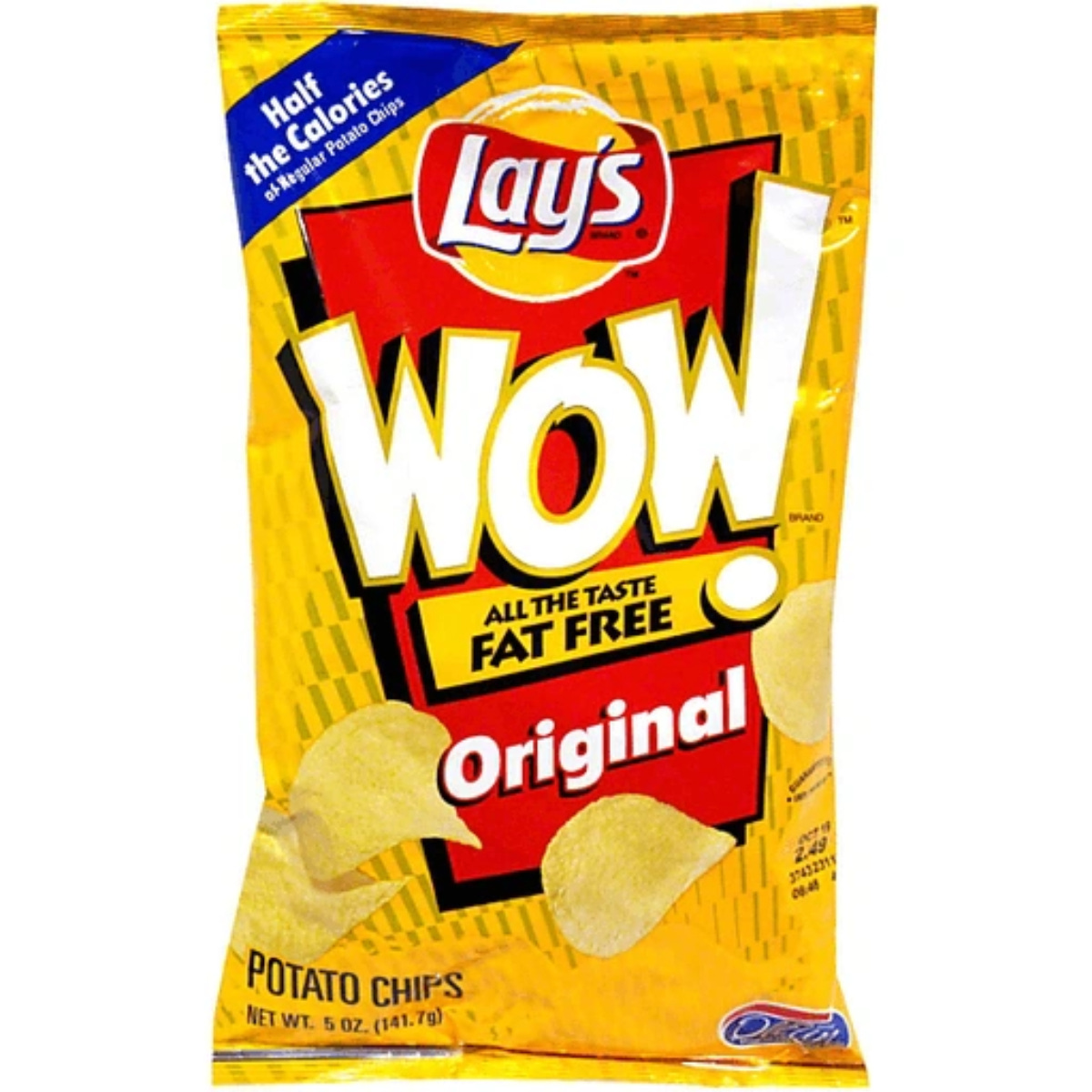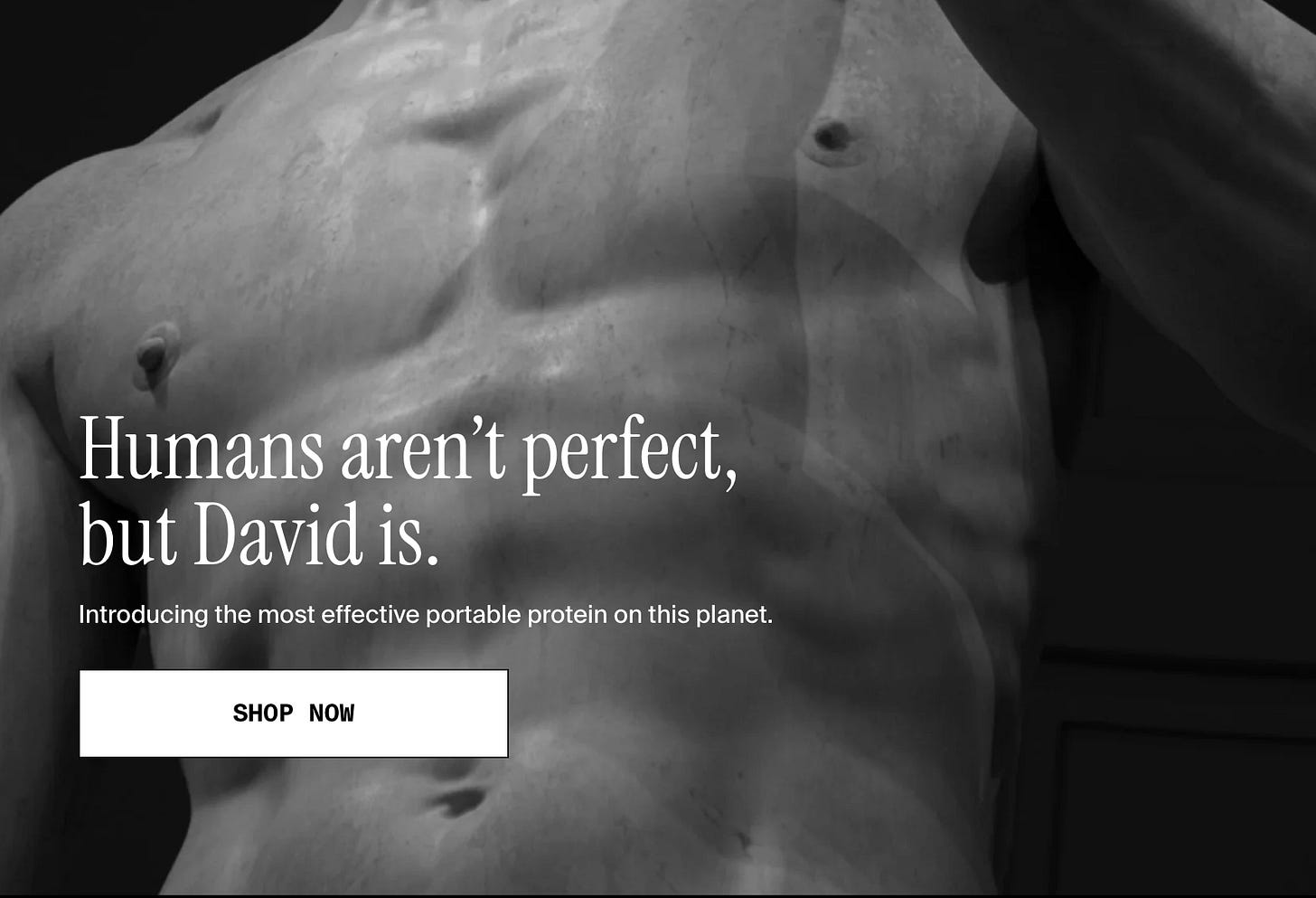David protein bars are a diet in disguise
Big muscles, bold claims, and the return of 90s diet culture. My David protein bar review.
Hello, readers! We’re taking a short break from our 6-week label reading series because…we need to talk about some products. This week, I’m reviewing David protein bars.
I’m trying out a video review this week, along with my usual text post. The video is just a summary; there’s a lot more information in the text version below.
I’m not sure exactly when it happened, but suddenly this bar was everywhere on social media. In the age of social media and influencer marketing, it’s hard to tell whether products have blown up because people genuinely love them, or because there’s a massive marketing budget behind the scenes. I think it’s the latter in this scenario, but in any case, I’m here talking about it too.
Before I even looked into these bars - just from the packaging - I knew they weren’t made by a guy named David. The gold foil wrapper, the bold “David” across the front. My brain immediately went to Michelangelo’s David, and I thought: you’ve got to be kidding me.
Yes, it’s named after that David. The world-famous statue I once stood in a sweltering line to see in Florence, Italy.
In case you forgot, we’re talking about a protein bar here.
With marketing this loud, this confident, and this self-congratulatory, the bar is set HIGH. I’m expecting to be blown away. I’m expecting snack aisle greatness.
Alright, let’s see if this protein bar really belongs in a museum.
🛒 This product review is free to read. But if you find it helpful, consider upgrading to a paid subscription.
Paid members get access to my full grocery aisle guides with product recommendations, ingredient deep dives, and evidence-based takes on food trends and headlines.
Thanks for being here 💚
A big part of this review will focus on the health claims and marketing. But first, let’s block out the noise for a moment and take an objective look at the Nutrition Facts and ingredient list.
Nutrition profile and ingredients
The Chocolate Chip Cookie Dough flavour contains 1.5 g of fat, including 1 g of saturated fat, coming from coconut oil and chocolate, to a lesser extent. David also provides 120 mg of sodium from added salt. Each serving provides 14 g of carbohydrates from maltitol, allulose, and tapioca starch. There is 0 g of fibre and 0 g of sugar in this bar. Each bar contains 28 g of protein, sourced from both milk protein powder and egg whites.
The fat replacer: EPG
David keeps its low-fat, low-calorie status thanks to a fat replacer called EPG (short for esterified propoxylated glycerol).
EPG is a fat-like substance made from rapeseed oil (canola) that’s been heavily modified to resist digestion by the human body. Because it isn’t fully absorbed, it provides just 0.7 calories per gram (a fraction of the 9 calories per gram in regular fats). This lets the bar maintain a creamy texture and mouthfeel (what fats would typically add) while reducing calories.
The company that created EPG was acquired by David protein, so they now own the rights to their own fat substitute.
It’s not disclosed how much EPG is used in each bar, but at higher doses, it’s been linked to digestive issues like gas, bloating, and oily spotting (yes, from your butt). It’s been called a “new and improved” version of Olestra, the infamous 1990s fat replacement that had nasty digestive side effects (like the be-aware-of-your-nearest-bathroom-at-all-times and hold-on-to-your-freaking-hats type of side effects). Needless to say, these products didn’t last long.
To be fair, EPG appears to have fewer GI side effects than Olestra, because it remains solid at body temperature (so the oily substance leaking out of your back end is less likely). But let’s not forget: it’s still a non-digestible fat-like substance designed to move through your gut unchanged. There's always a risk of digestive distress when a product relies on something your body was meant to malabsorb.
Non-sugar sweeteners
Similarly, David keeps its no-sugar status thanks to a cocktail of non-sugar sweeteners. This includes 8 g of maltitol (a sugar alcohol), glycerin, allulose, sucralose (also known by the brand name Splenda), and acesulfame potassium.
When I read the ingredient list, I was genuinely shocked to see this combo, especially sucralose and acesulfame potassium. Not because there’s anything inherently dangerous about these sweeteners when used appropriately, but because it feels so off-brand for a bar that claims to be superior, revolutionary, the “most effective portable protein on the planet.”
It turns out David initially used monk fruit and stevia (more expensive and seemingly “elite” sweeteners), but changed the formulation due to taste complaints and aftertaste. The newer version swaps in artificial sweeteners for what they call a “better-tasting product” compared to the original formula.
Here’s the thing. This bar delivers an exceptional amount of protein - 28 grams, the equivalent of a full scoop of protein powder. For context, most protein bars contain around 12–20 g. But the reason most bars don’t push protein that high isn’t because they’ve never thought of it. It’s because it usually tastes terrible. The only way to fix that is to add a heavy dose of sugar or non-sugar sweeteners.
Additional ingredients
Beyond the fat and sweeteners, the rest of the ingredient list is fairly minimal. These include the common emulsifier soy lecithin (you can read more about that here), natural flavours (check out my deep dive here), unsweetened chocolate and cocoa powder. These are all commonly found in the protein bar category and are not concerning.
Review of product claims
The protein bar category is known for cringe marketing and over-the-top product names. I get it: in such a dynamic and volatile category, you’ve gotta stand out somehow. The David bar is no exception. Most of the marketing used across David’s channels centres around one theme: superiority. Here are a few examples:
“Unwrap greatness.”- Come on 🙄.
“The most effective portable protein on this planet.”- What even?!
“Designed for the human body.”- Except for the fat replacer, which was very much designed for the opposite.
“We thank our predecessors in the protein industry. We’ll take it from here.”- Oh, ok.
And in case that wasn’t enough, they don’t just list ingredients, they’ve grouped them into “systems.” A protein system, a binding system, a fat system, and a flavour system. Please don’t let this impress you. It means absolutely nothing.
David is full of himself. And the only thing that truly sets this bar apart is its protein content. As I mentioned previously, each bar has 28 g of protein, significantly more than most bars on the market, which typically contain 12-20 g per bar.
But beyond the protein content, there’s nothing revolutionary here. And ironically, the only way they can hit that protein number while keeping the fat, calories, and sugar low is by using the same types of artificial sweeteners and fat replacements that diet food companies have been using for decades. High protein, low carb, low fat. Hmm, sound familiar?
David bars are just diet bars disguised by “optimal” protein and superiority.
A significant amount of marketing is focused on David’s claimed effectiveness at helping you achieve the “optimal”, body type with a low body fat percentage. Be like David. For example, the website states:
“The optimal protein for your optimal form. Build strength… lose weight… be beautiful.” 🫠
To say I hate this product is an understatement. It represents everything that’s wrong with the modern “healthy food” space, especially in the fitness industry. It’s elitist. It puts certain food on a pedestal. It pushes the idea that health is about how you look. That your worth is tied to your body fat percentage. And it fuels the obsession over protein. Sure, protein is important. But it’s not the only thing that is.
This product also depicts a dangerous side to modern food marketing. Yes, we’ve been here before. Products like Slim Fast and low fat, low carb diets like Atkins ruled in the 80s, 90s, and early 2000s. But the difference is that in those years, it was clear that a food was selling weight loss. But since we’ve had a body positivity movement in recent years, telling people to lose weight can sometimes be a bit taboo. Companies have to walk this line very carefully. So instead of being as obvious as a product called “slim fast” or using statements like “lose weight and feel great”, it’s disguised under the cover of giving you “more” protein, helping you become your “optimal” self.
It’s still the diet industry. It just looks different now.
David isn’t built for health. If this bar were truly about health, it wouldn’t rely on zero-nutrient fat substitutes like EPG. It’s 2025. We don’t need to be afraid of fat. We don’t need to chase low-calorie food under the belief that low calorie = better for you, at the expense of any real nutrition. I really thought we had moved past this. This isn’t health. It’s performative. And it’s exhausting.
This bar is a walking contradiction.
This product is dripping with obnoxious claims about being superior and optimal, yet it’s built on the very ingredients that wellness culture claims to reject. In an era where “natural” is better, David protein bars have somehow found a way to present a low-calorie protein bar loaded with sweeteners and synthetic fat as the key to unlock optimal health. While at the same time, criticizing their “predecessors” in the protein industry for essentially selling the same products. Don’t be fooled, this bar is part of the $90 billion weight loss industry, repackaged in gold foil. It’s selling body ideals, it’s appealing to the pressure to reach your “optimal” smallest body size, no matter the cost.
TL’DR:
Don’t do it! There are better options out there for bars that will actually fuel you. You can check out my tips to choosing a protein bar and 6 solid options here.
Sharing one of my favourite weekly reads with you - “The Grocery Cart” newsletter by Build Up Dietitians. It’s a weekly newsletter with food-related news. Be sure to check it out!
Revolutionary or diet in disguise - what do you think? I’d love to hear about your opinion or experience with David protein. Let’s chat in the comment section below!
Talk soon,
~Brittany
“The Grocery Edit” is written by Brittany Raftis, MScFN, RD. She works as a Registered Dietitian and is passionate about helping people sort through the confusion of ingredients and nutrition facts to reduce stress surrounding daily food choices. She uses an evidence-based approach to clear up misinformation about nutrition and help people select the right products to support their health and enjoyment of food.












Thanks for the warning. That photo of the box of SlimFast bars brought back memories. 😬
Excellent review, Brittany! My thought: How did David get his fine physique? By rigorous activity and eating ONLY NATURAL FOODS. ;-)